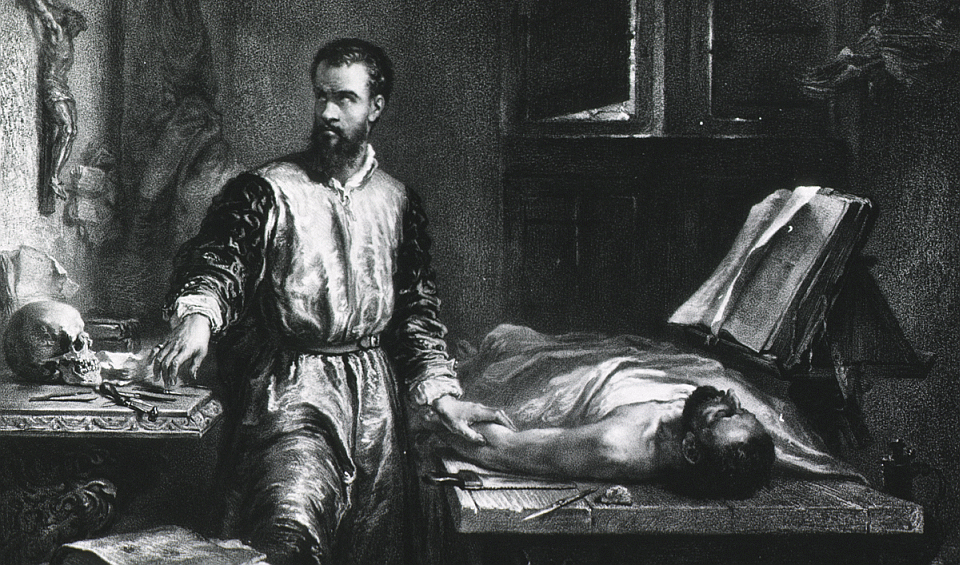Vesalius: the 500th birthday of a scientific revolutionary
In this era of dogma, we could do with more of Vesalius's open-mindedness.

Want to read spiked ad-free? Become a spiked supporter.
New Year’s Eve marked the 500th anniversary of the birth of Andries van Wesel, the Flemish physician better known to posterity as Andreas Vesalius.
Born on 31 December 1514 in Brussels, which was then part of the Holy Roman Empire, Vesalius came from a family of physicians. Still, his talent was precocious. On the day of his graduation from the University of Padua in 1537 – he was then aged 22 – the university promptly offered him a professorship. Within five years, Vesalius had already published what was to become his magnum opus, On the Fabric of the Human Body. He was just 27.
Vesalius, like his grandfather, went on to become personal physician to the Holy Roman Emperor, Charles V. He died aged 49, having been shipwrecked on the Greek island of Zakynthos while attempting to undertake a pilgrimage to the Holy Land in October 1564.
But Vesalius’s historical importance was not due to his prodigious talent as a clinician; rather, it lay in the impact he had on the way we think about medicine and the body. As Roy Porter’s Blood and Guts: A Short History of Medicine illustrates, before Vesalius, dissections, during which most medical teaching occurred, were rather ceremonial affairs. Presided over by a physician ‘decked in academic robes [and] seated on a throne’, while a surgeon did the dirty work, the point of a dissection was to demonstrate the received wisdom of the Ancient Roman physician Galen. It was not to learn anything new from the real body set before the surgeon.
And this is why Vesalius stood out. While at Padua, he made a radical break with the past by performing the dissections himself. He focused not on what the weight of tradition told him he should see, but on what he actually saw. And, as a result, Galen’s anatomy, derived from his dissections of Barbary apes and dogs, was found by Vesalius to contain numerous errors: the human jaw was one bone rather than two; the liver did not contain five lobes; and there were no holes in the septum of the heart to allow blood to flow between its two ventricles. As Porter puts it in The Greatest Benefit to Mankind, Vesalius ‘restored Galenic anatomy in such a way as to transcend it’.
Vesalius’s students, most prominently Fallopius (of the Fallopian tube), continued his project; every correction made to Vesalius’s own errors (and these naturally were plentiful) reinforced his intellectual breakthrough rather than diminishing it. His magnum opus, the Fabrica, was also an immense step forward from mediaeval medical books, presenting beautifully rendered and naturalistic depictions of his dissections, drawn by professional artists and printed as engravings.
But, as the title of Ludwig Edelstein’s famous 1940s essay, ‘Vesalius, the Humanist’, suggests, it was the humanistic ideas of Vesalius’s time, just as much as his special genius, that made his work so important. So although Vesalius’s radical attitude broke apart the traditional dogmas of the time, he was neither alone among his contemporaries in the Renaissance in pushing the boundaries of anatomy, nor divorced from the groundwork laid by the classical physicians such as Galen or Arab physicians such as Avicenna.
1543, the year his Fabrica was published, was also the year of Copernicus’s On the Revolution of the Heavenly Bodies, which, through its advocacy of a heliocentric universe, revolutionised astronomy just as much as Vesalius’s Fabrica revolutionised medical science. The arrival of the two books is today considered the starting point for the scientific revolution. The intellectual climate in which Vesalius worked was one in which the established way of doing things was rapidly crumbling. The discovery of America 50 years previously had changed the way the world was understood and unleashed economic change, while the Reformation was tearing apart the spiritual and intellectual certainties of Europe. Vesalius was inspired by the intellectual spirit of the time to explore the human body as it had never been explored before – and our lives are far longer and healthier today as a consequence.
Today, when some are trying to use the findings of science in a dogmatic and authoritarian way, it is worth remembering the 500-year-old break with tradition that Vesalius and his contemporaries initiated. Rarely has that old Royal Society motto – that scientific authority rests ‘on the word of no one’ – been so vitally enacted.
Robin Walsh is a trainee doctor at the University of Sheffield.
Who funds spiked? You do
We are funded by you. And in this era of cancel culture and advertiser boycotts, we rely on your donations more than ever. Seventy per cent of our revenue comes from our readers’ donations – the vast majority giving just £5 per month. If you make a regular donation – of £5 a month or £50 a year – you can become a and enjoy:
–Ad-free reading
–Exclusive events
–Access to our comments section
It’s the best way to keep spiked going – and growing. Thank you!








Comments
Want to join the conversation?
Only spiked supporters and patrons, who donate regularly to us, can comment on our articles.